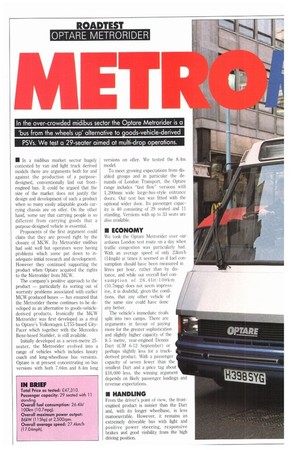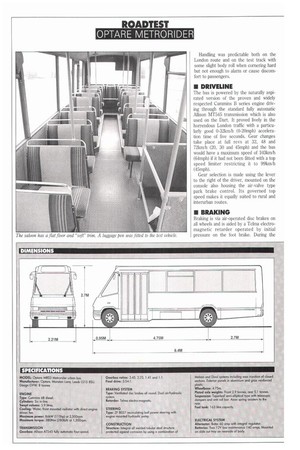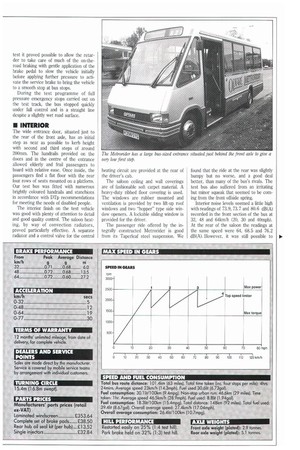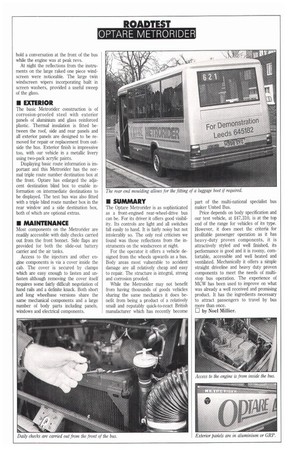In the over-crowded midibus sector the Optare Metrorider is a
Page 30

Page 32

Page 33

Page 34

If you've noticed an error in this article please click here to report it so we can fix it.
'bus from the wheels up' alternative to •oods-vehicle-derived PSVs. We test a 29-seater aimed at multi-dro. o•erations.
in In a midibus market sector hugely contested by van and light truck derived models there are arguments both for and against the production of a purposedesigned, conventionally laid out frontengined bus. It could be argued that the size of the market does not justify the design and development of such a product when so many easily adaptable goods carrying chassis are on offer. On the other hand, some say that carrying people is so different from carrying goods that a purpose-designed vehicle is essential.
Proponents of the first argument could claim that they are proved right by the closure of MCW. Its Metrorider midibus had sold well but operators were having problems which some put down to inadequate initial research and development. However they continued supporting the product when Optare acquired the rights to the Metrorider from MCW.
The company's positive approach to the product — particularly its sorting out of warranty problems associated with earlier MCW produced buses — has ensured that the Metrorider theme continues to be developed as an alternative to goods-vehiclederived products. Ironically the MCW Metrorider was first developed as a rival to Optare's Volkswagen LT55-based CityPacer which together with the Mercedes Benz-based Starider, is still available.
Initially developed as a seven-metre 25seater, the Metrorider evolved into a range of vehicles which includes luxury coach and long-wheelbase bus versions. Optare is at present concentrating on bus versions with both 7.04m and 8.4m long versions on offer. We tested the 8.4m model.
To meet growing expectations from disabled groups and in particular the demands of London Transport, the Optare range includes "fast flow" versions with 1,200mm wide large-bus-style entrance doors. Our test bus was fitted with the optional wider door. Its passenger capacity is 40 consisting of 29 seated and 11 standing. Versions with up to 33 seats are also available.
• ECONOMY
We took the Optare Metrorider over our arduous London test route on a day when traffic congestion was particularly bad. With an average speed of only 23km1i (14mph) at times it seemed as if fuel consumption should have been measured in litres per hour, rather than by distance, and while our overall fuel consumption of 2 6.41itil 0 ()km (10.7mpg) does not seem impressive, it is doubtful, given the conditions, that any other vehicle of the same size could have done any better.
The vehicle's immediate rivals split into two camps. There are arguments in favour of paying more for the greater sophistication and slightly higher capacity of the 8.5 metre, rear-eru.,,ined Dennis Dart (CM 6-12 September) or perhaps slightly less for a truckderived product. With a passenger capacity of seven fewer than the smallest Dart and a price tag about £10,000 less, the winning argument depends on likely passenger loadings and revenue expectations.
• HANDLING
From the driver's point of view, the frontengined product is noisier than the Dart and, with its longer wheelbase, is less manoeuvrable. However, it remains an extremely driveable bus with light and positive power steering, responsive brakes and good visibility from the high driving position. Handling was predictable both on the London route and on the test track with some slight body roll when cornering hard but not enough to alarm or cause discomfort to passengers.
• DRIVELINE
The bus is powered by the naturally aspirated version of the proven and widely respected Cummins B series engine driving through the standard fully automatic Allison MT545 transmission which is also used on the Dart. It proved lively in the horrendous London traffic with a particularly good 0-32km/h (0-20mph) acceleration time of five seconds. Gear changes take place at full revs at 32, 48 and 72krn/h (20, 30 and 45mph) and the bus would have a maximum speed of 103Iun/h (64mph) if it had not been fitted with a top speed limiter restricting it to 99kmih (45mph).
Gear selection is made using the lever to the right of the driver, mounted on the console also housing the air-valve type park brake control. Its governed top speed makes it equally suited to rural and interurban routes.
• BRAKING
Braking is via air-operated disc brakes on all wheels and is aided by a Telma electromagnetic retarder operated by initial pressure on the foot brake. During the test it proved possible to allow the retarder to take care of much of the on-theroad braking with gentle application of the brake pedal to slow the vehicle initially before applying further pressure to activate the service brake to bring the vehicle to a smooth stop at bus stops.
During the test programme of full pressure emergency stops carried out on the test track, the bus stopped quickly under full control and in a straight line despite a slightly wet road surface.
II INTERIOR
The wide entrance door, situated just to the rear of the front axle, has an initial step as near as possible to kerb height with second and third steps of around 200min. The handrails provided on the doors and in the centre of the entrance allowed elderly and frail passengers to board with relative ease. Once inside, the passengers find a flat floor with the rear four rows of seats mounted on a platform. Our test bus was fitted with numerous brightly coloured handrails and stanchions in accordance with DTp recommendations for meeting the needs of disabled people.
The interior finish on the test vehicle was good with plenty of attention to detail and good quality control. The saloon heating, by way of convection radiators, proved particularly effective. A separate radiator and a control valve for the central heating circuit are provided at the rear of the driver's cab.
The saloon ceiling and wall coverings are of fashionable soft carpet material. A heavy-duty ribbed floor covering is used. The windows are rubber mounted and ventilation is provided by two lift-up roof windows and two "hopper" type side window openers. A lockable sliding window is provided for the driver.
The passenger ride offered by the integrally constructed Metrorider is good from its Taperleaf steel suspension. We found that the ride at the rear was slightly bumpy but no worse, and a good deal better, than many of the bus's rivals. The test bus also suffered from an irritating but minor squeak that seemed to be coming from the front offside spring.
Interior noise levels seemed a little high with readings of 73.9, 73.7 and 80.6 dB(A) recorded in the front section of the bus at 32, 48 and 641unili (20, 30 and 40mph). At the rear of the saloon the readings at the same speed were 64, 68.5 and 76.2 dB(A). However, it was still possible to hold a conversation at the front of the bus while the engine was at peak revs.
At night the reflections from the instruments on the large raked one piece windscreen were noticeable. The large twin windscreen wipers incorporating built in screen washers, provided a useful sweep of the glass.
• EXTERIOR
The basic Metrorider construction is of corrosion-proofed steel with exterior panel's of aluminium and glass reinforced plastic. Thermal insulation is fitted between the roof, side and rear panels and all exterior panels are designed to be removed for repair or replacement from outside the bus. Exterior finish is impressive too, with our vehicle in a metallic livery using two-pack acrylic paints.
Displaying basic route information is important and this Metrorider has the normal triple route number destination box at the front. Optare has enlarged the adjacent destination blind box to enable information on intermediate destinations to be displayed. The test bus was also fitted with a triple blind route number box in the rear window and a side destination box, both of which are optional extras.
• MAINTENANCE
Most components on the Metrorider are readily accessible with daily checks carried out from the front bonnet. Side flaps are provided for both the slide-out battery carrier and the air tanks.
Access to the injectors and other engine components is via a cover inside the cab. The cover is secured by clamps which are easy enough to fasten and unfasten although removing the cover itself requires some fairly difficult negotiation of hand rails and a definite knack. Both short and long wheelbase versions share the same mechanical components and a large number of body parts including panels, windows and electrical components.
• SUMMARY
The Optare Metrorider is as sophisticated as a front-engined rear-wheel-drive bus can be. For its driver it offers good visibility. Its controls are light and all switches fall easily to hand. It is fairly noisy but not intolerably so. The only real criticism we found was those reflections from the instruments on the windscreen at night.
For the operator it offers a vehicle designed from the wheels upwards as a bus. Body areas most vulnerable to accident damage are all relatively cheap and easy to repair. The structure is integral, strong and corrosion proofed.
While the Metrorider may not benefit from having thousands of goods vehicles sharing the same mechanics it does benefit from being a product of a relatively small and reputably quick-to-react British manufacturer which has recently become
part of the multi-national specialist bus maker United Bus.
Price depends on body specification and our test vehicle, at 247,310, is at the top end of the range for vehicles of its type. However, it does meet the criteria for profitable passenger operation as it has heavy-duty proven components, it is attractively styled and well finished, its performance is good and it is roomy, comfortable, accessible and well heated and ventilated. Mechanically it offers a simple straight driveline and heavy duty proven components to meet the needs of multistop bus operation. The experience of MCW has been used to improve on what was already a well received and promising product. It has the ingredients necessary to attract passengers to travel by bus more than once.
El by Noel Millier.












































































































